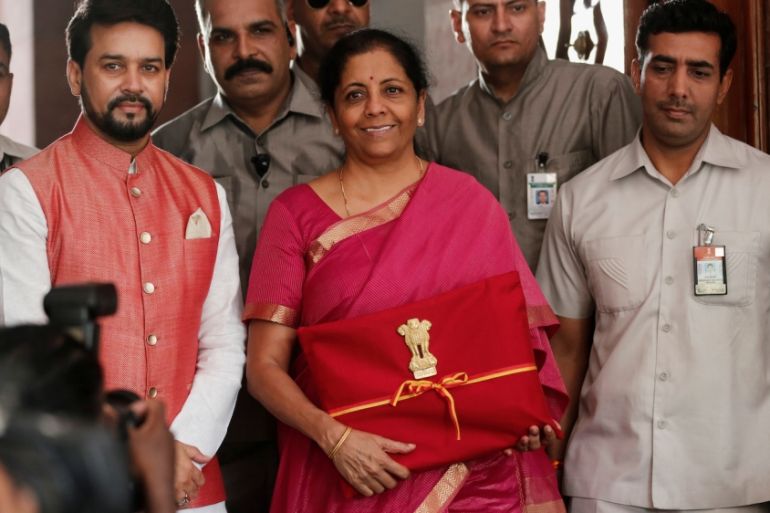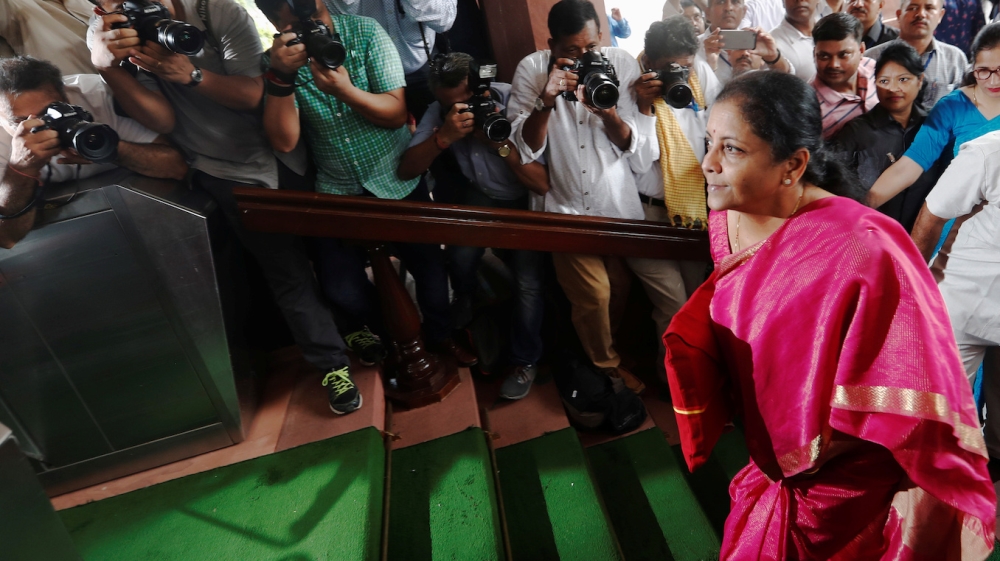India’s budget targets investment-led growth
The first annual budget of the Modi 2.0 government tightened the purse strings and revised down fiscal expenditure.

Mumbai, India – More infrastructure spending, an easier environment for foreign investors and a clean-up of public bank debts. Those were the promises India‘s new Finance Minister Nirmala Sitharaman made in her first budget speech on Friday, moves that analysts say India desperately needs, but that the government may not be able to afford.
Backed by a solid mandate following a resounding victory in recent elections, Sitharaman said the government is “determined to take India to new heights” as she presented the budget in Parliament, the first of Prime Minister Narendra Modi’s second-term government.
Keep reading
list of 4 items‘Triple spending’: Zimbabweans bear cost of changing to new ZiG currency
‘We share with rats’: Neglect, empty promises for S African hostel-dwellers
Thirty years waiting for a house: South Africa’s ‘backyard’ dwellers
Sitharaman raised import tariffs on nearly 75 items including gold and car parts in the budget and increased taxes on the rich to help pay for recapitalising banks and supporting small business in a bid to revive sagging growth.
While her proposals focused on how the government will increase revenues and attract private investment amid signs of an economic slowdown – it was not the bumper spending package many analysts had predicted.
Modi has set a target of growing India into a $5 trillion economy by 2024-2025, up from $2.7 trillion. The government’s annual economic report published on Thursday said it will try to achieve that through higher investments, savings and exports in the way China’s growth was propelled.
Compared with February’s interim budget in which a host of new policy measures were announced (which critics described as populist vote-winning strategies), Friday’s budget proposals revealed more fiscal prudence within the Finance Ministry.
India’s fiscal deficit – the excess amount it spends compared with how much it receives in revenues – will be brought down to 3.3 percent of the size of India’s economy from 3.4 percent, Sitharaman said, surprising many who had expected a loosening of purse strings as India embarks on an aggressive investment-driven growth plan.
“If you look at the figures though, there’s little fiscal space for increased government spending given the current revenue shortfall,” Manan Sabnavis, Chief Economist at CARE Ratings, told Al Jazeera. “The government currently needs to raise [$21bn] total revenue – a considerable sum – so I was not expecting any significant stimulus announcement”.
As the government attempts to further diversify its funding sources, India has announced that it will start borrowing in foreign currency in a move some analysts have described as “radical” but one that comes at the right time.
“Despite some risks, this needs to be explored partly to ease pressures in domestic markets,” Sugata Bhattarcharya, chief economist at Axis Bank told Al Jazeera. “The success will depend on perceptions of India’s macro stability. Fiscal prudence and stable inflation is likely to attract investor appetite,” he added.
Domestic borrowing has been constrained in recent months due to a liquidity crunch after the government stepped in last year to take over Infrastructure Leasing & Financial Services (IL&FS), a non-bank lender. Many analysts, therefore, welcomed the news that the government will now provide a credit guarantee for public sector banks for buying stressed assets owned by non-bank financial companies (NBFCs).
Meanwhile, India’s ailing public sector banks are set to receive $700bn in an attempt to replenish credit in the economy.
And the media, aviation and insurance sectors will be available for foreigners to invest in to draw more money into the economy.
‘The common man’
After focussing on business-friendly measures like reducing red tape, greater digitisation of government administration and streamlining labour reforms, the finance minister confirmed the continuation of a number of policies designed to help the “common man”.
Sitharaman announced the government will build 1.5 million homes for the rural poor, and provide each one with a toilet, clean cooking gas and electricity. These promises build on schemes launched in Prime Minister Modi’s previous term in power. Analysts have previously credited the schemes with helping the ruling party increase its vote share, particularly among women, in the last election.
A 3,000 Indian rupee ($44) a month pension for informal workers such as farm labourers or builders, first introduced in February’s interim budget, has also been expanded to include 30 million small retail businesses. Income tax requirements have also been withdrawn for those earning less than 500,000 Indian rupees ($7,288) annually.

A 45-year-high unemployment rate is arguably one of the country’s most pressing issues, hindering India’s consumption-led growth and even threatening social unrest. To help tackle fears of “jobless growth”, in which the economy pushes ahead but does not create enough employment, the government responded with tax cuts for start-ups, offering help to rural artisans excluded from the global supply chain and announcing the streamlining of labour laws.
Budgeting for the climate crisis
Though 21 cities are expected to run out of water next year according to a 2018 report by Niti Aayog, a public think-tank, the government reaffirmed its commitment to providing piped water to every home by 2024.
A total of $103m has been allocated to a new integrated water and river management ministry, tasked with delivering the goal, cleaning up polluted rivers and improving India’s water security.
While mention of measures to tackle India’s horrific air quality (the country is home to 14 out of 20 of the most polluted cities in the world, according to Greenpeace) remained absent from the budget speech, plans to increase the availability of “environmentally friendly transport” in the form of electric vehicles featured prominently.
Under the Faster Adoption of Electric Vehicles-II scheme, the government will spend heavily over the next three years to ensure that Indians’ growing demand for owning their own car will increasingly be met with the electric kind. Analysts have also welcomed a new tax benefit amounting to $2,917 for every person when purchasing a new electric car, which many hope will mean more low-income consumers can enter the market.
“The waiver is very welcome since it will produce a lot more innovation in the way electric vehicles are financed,” Kanika Chawla, Director at the Centre For Energy, Environment and Water, a policy research firm, told Al Jazeera.
“It signals to auto-loan makers, who are a large part of the debt cycle in India, that there will be a lot more activity in this space and this will have a direct consumer benefit”.
Speaking after Friday’s Parliament session, Prime Minister Modi said the budget is “one of hope” and “will boost India’s development in the 21st Century”.